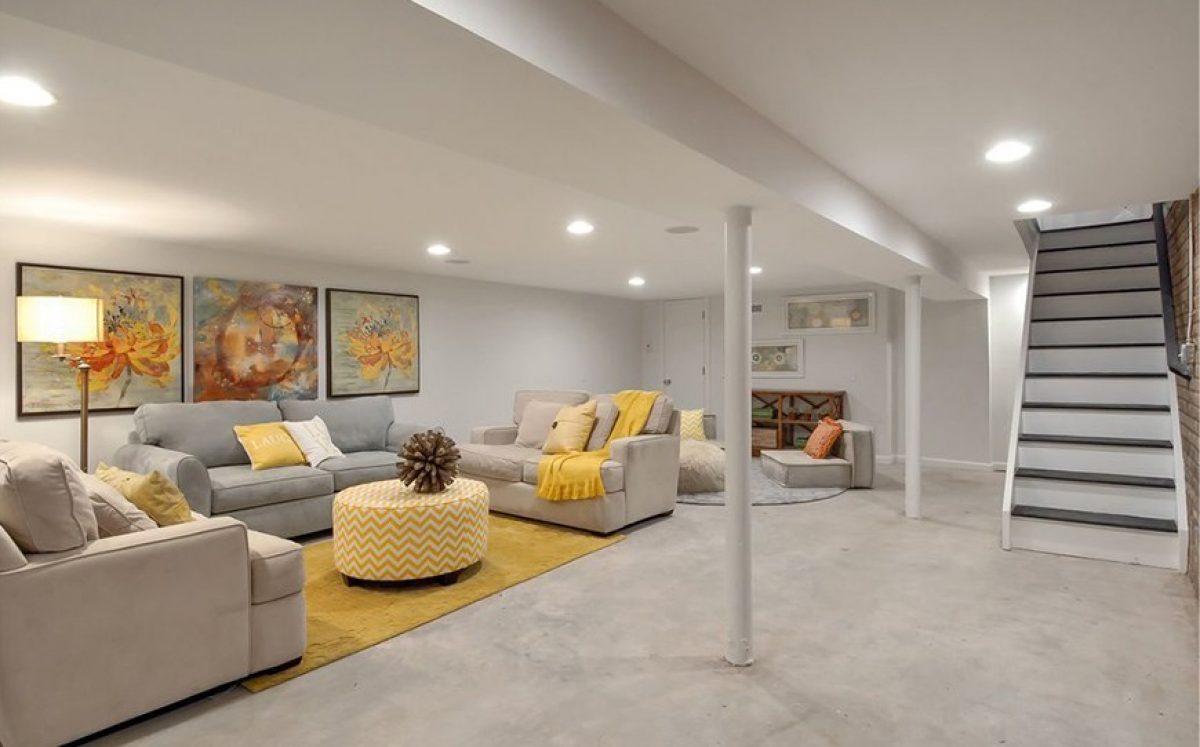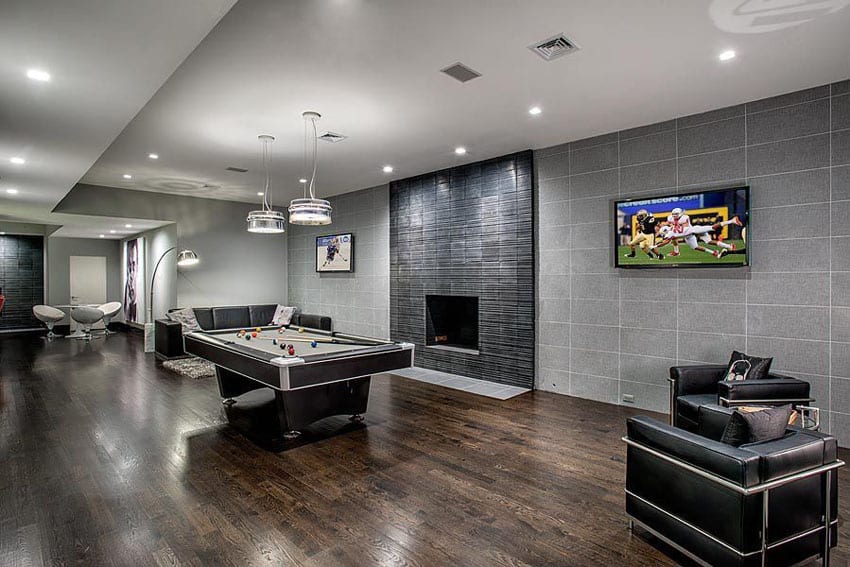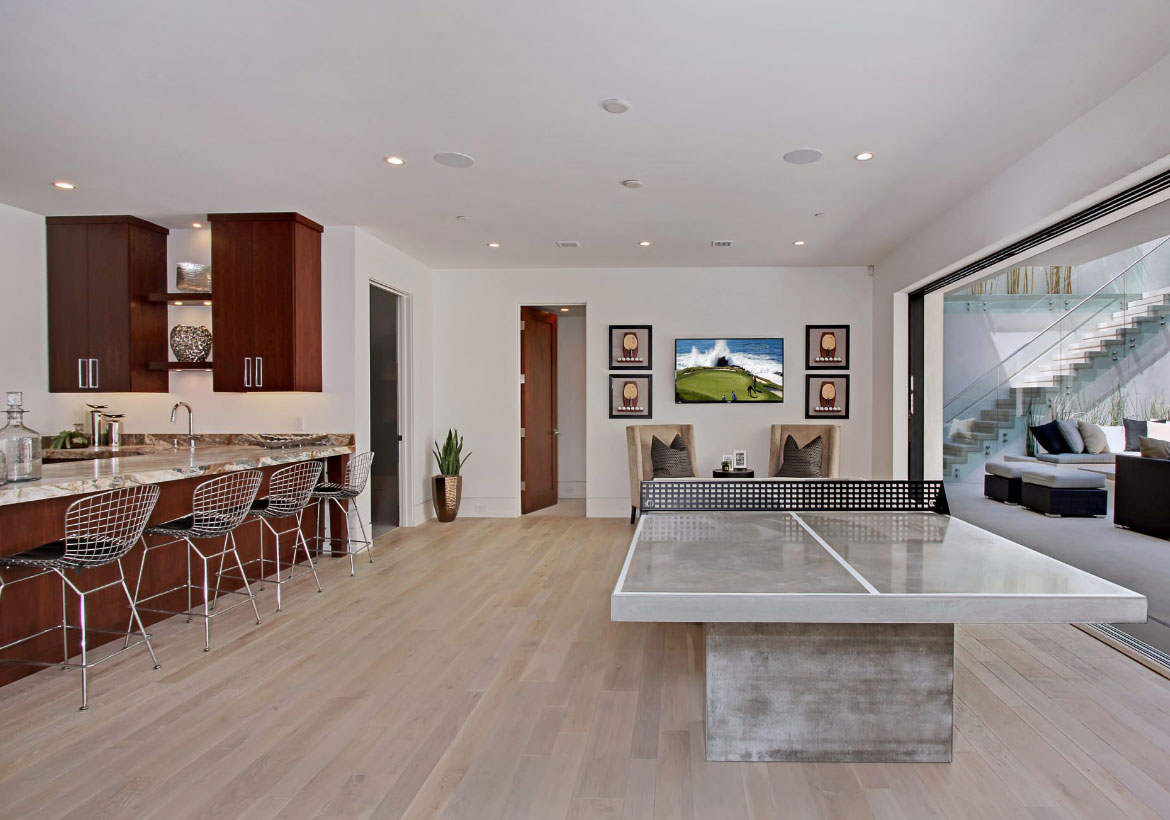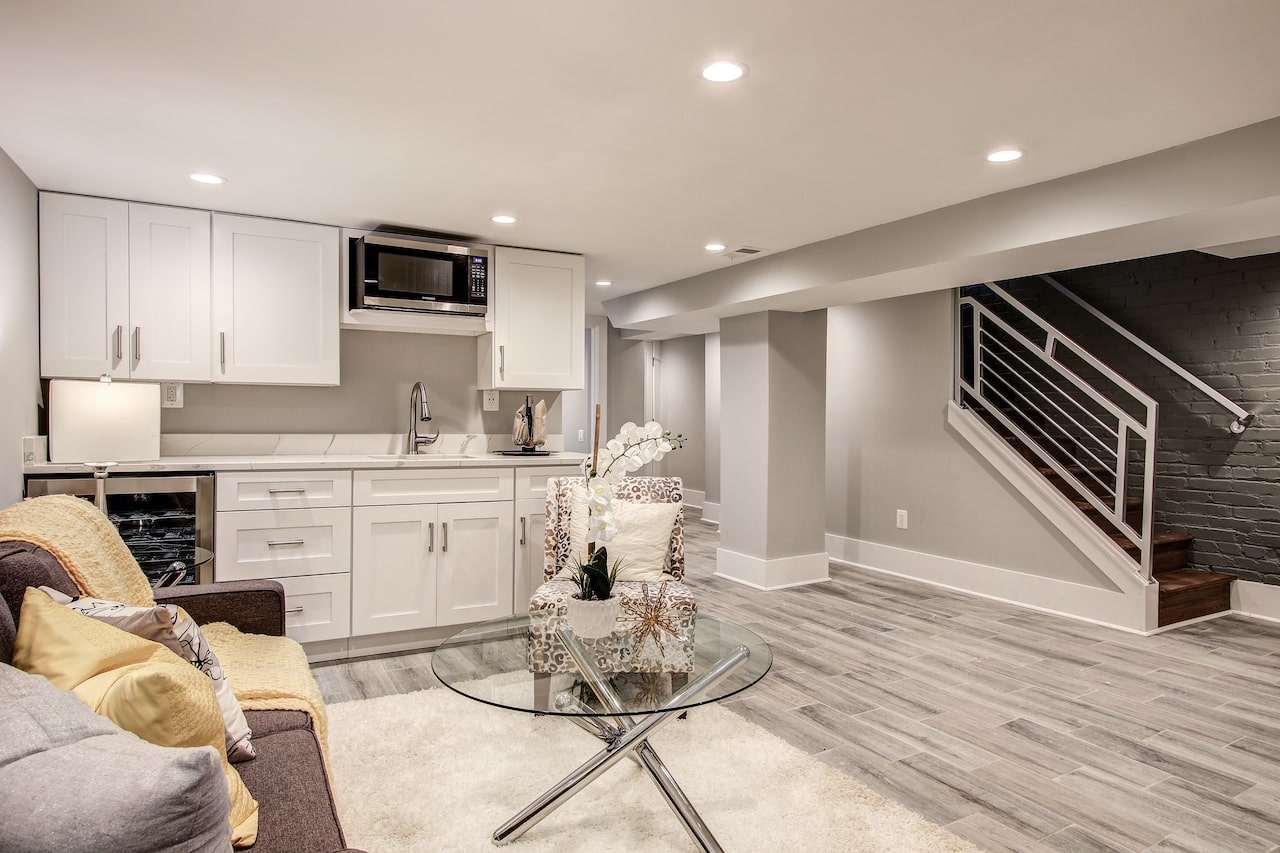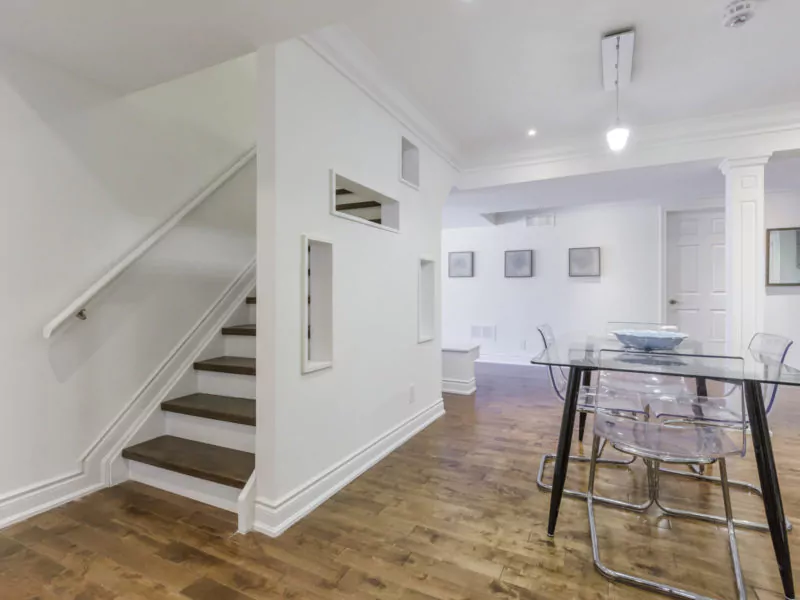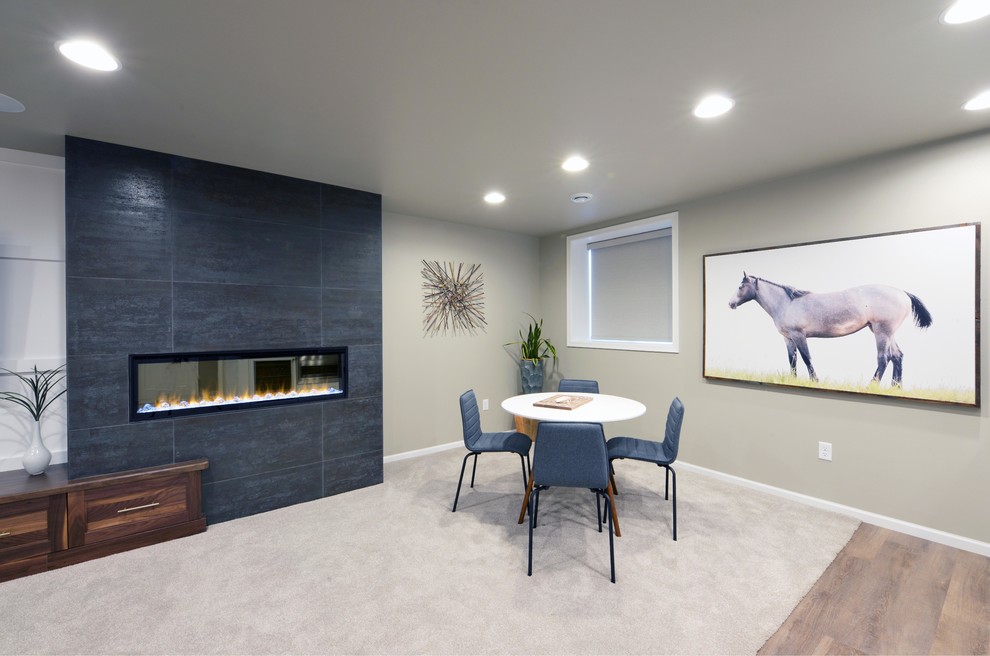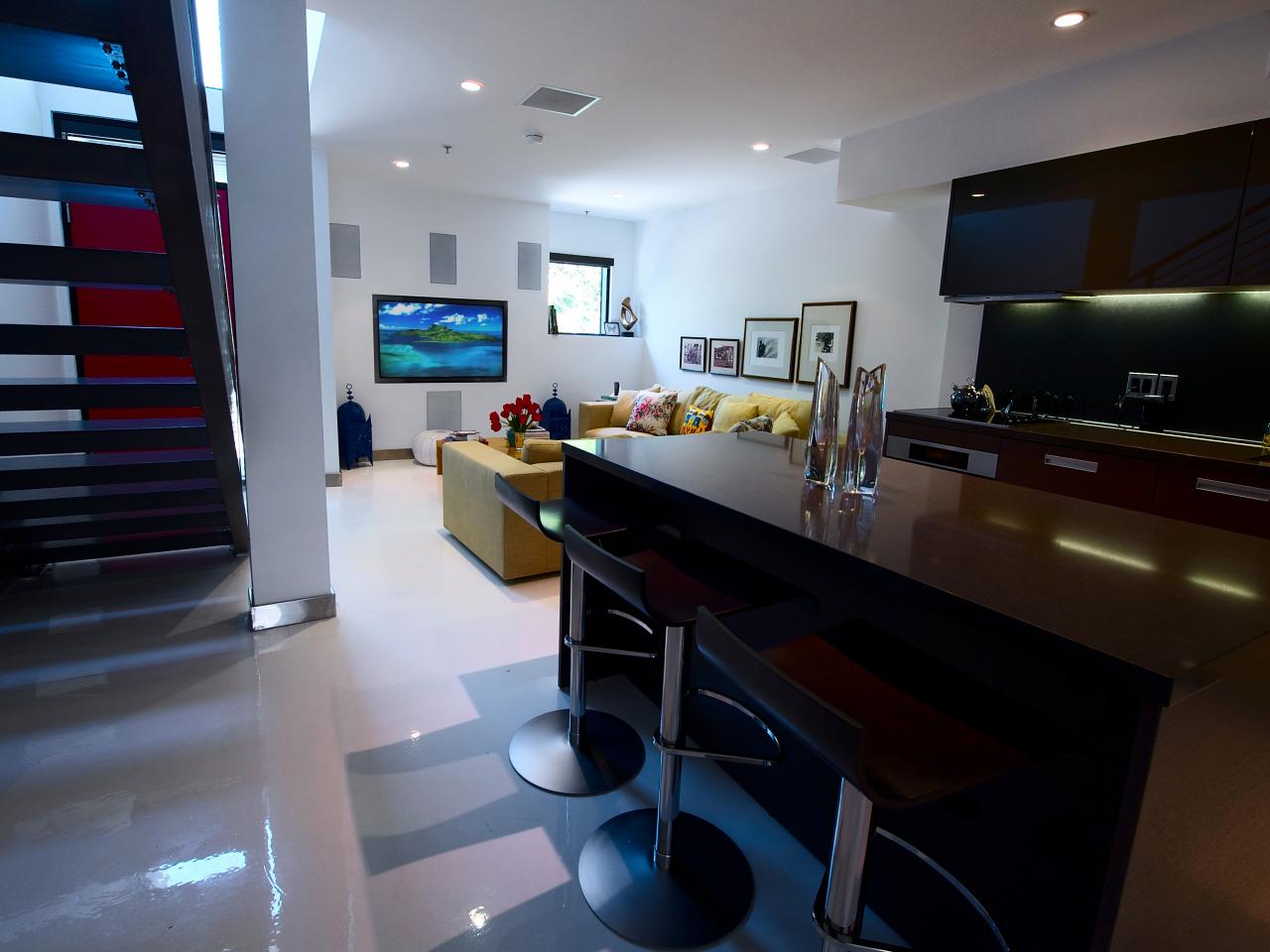Best Materials for Modern Basement Flooring
When it comes to modern basement flooring, the choice of material plays a crucial role in both functionality and aesthetics. Basements are unique spaces that often require flooring solutions that can handle moisture, provide warmth, and add to the overall style of the home. Whether you’re finishing your basement for the first time or looking to upgrade its current look, selecting the right material is key to creating a space that’s both practical and visually appealing.
- Luxury Vinyl Plank (LVP): Luxury Vinyl Plank is a top choice for modern basement flooring due to its durability and water resistance. LVP mimics the appearance of natural wood, offering a warm, stylish look without the worry of moisture damage. Its ease of installation, often available in click-and-lock formats, makes it a favorite for DIY enthusiasts. Additionally, LVP provides a comfortable underfoot feel and can be paired with an underlayment for added insulation, making it perfect for basements that tend to be cooler.
- Engineered Hardwood: For those who love the classic appeal of hardwood floors but are concerned about basement conditions, engineered hardwood is an excellent alternative. Unlike traditional hardwood, engineered wood is made of a thin layer of real wood on top of a high-quality plywood base, making it more stable and less prone to warping in moist environments. It provides the same rich, timeless look as solid hardwood but with added resilience against the challenges basements present.
- Polished Concrete: Polished concrete is a modern, industrial choice that’s gaining popularity for basement flooring. This material is not only incredibly durable but also offers a sleek, contemporary look. With the option to stain or dye the concrete, homeowners can achieve a variety of colors and finishes, from high gloss to matte. Polished concrete is also easy to clean and maintain, making it a practical choice for high-traffic basement areas.
- Ceramic or Porcelain Tile: Tiles are a classic basement flooring option that combines durability with endless design possibilities. Ceramic and porcelain tiles are particularly well-suited for basements due to their resistance to moisture and stains. They come in a wide range of styles, from wood-look tiles to modern geometric patterns, allowing you to create a custom look that fits your home’s aesthetic. Additionally, tiles are easy to clean and can be heated from underneath, adding warmth to a typically cold space.
- Carpet Tiles: For those who prefer the comfort and warmth of carpet, carpet tiles offer a modern solution for basement flooring. Unlike traditional wall-to-wall carpeting, carpet tiles are modular, meaning they can be easily replaced if damaged. This makes them ideal for basements where moisture issues might occur. Available in various colors, textures, and patterns, carpet tiles allow for creative designs while providing a cozy, cushioned surface underfoot.
- Rubber Flooring: Rubber flooring is a versatile and durable option that’s particularly popular in home gyms, playrooms, and basements with high foot traffic. This material is water-resistant, shock-absorbent, and easy to clean, making it a practical choice for active households. Rubber flooring comes in rolls or tiles and is available in a range of colors and patterns. Its cushioned surface also adds comfort, reducing strain on joints during exercise or play.
- Cork Flooring: Cork flooring is an eco-friendly option that offers natural warmth and comfort. It is resilient and can handle the temperature fluctuations often found in basements. Cork is also naturally resistant to mold, mildew, and pests, making it a healthy choice for basement environments. Additionally, its unique texture and appearance can add a distinctive look to your basement space, making it feel more inviting.

Trends in Modern Basement Flooring Designs
Design trends in basement flooring have evolved significantly in recent years, with a focus on combining style, durability, and functionality. Modern basement floors are now seen as an extension of the home’s living space, and homeowners are increasingly looking for flooring options that reflect current design aesthetics while meeting the specific needs of a basement environment.
Mixed Material Flooring
One of the hottest trends in modern basement flooring is the use of mixed materials. This involves combining two or more types of flooring to create distinct zones within the basement. For example, you might use luxury vinyl planks in a living area and transition to rubber flooring in a workout space. This not only adds visual interest but also enhances the functionality of the space, catering to different activities while maintaining a cohesive design.
Bold Patterns and Geometric Designs
Gone are the days when basement floors were plain and utilitarian. Today, bold patterns and geometric designs are making their way into basement flooring, adding a dynamic element to the space. Whether it’s through patterned tiles, carpet tiles arranged in striking configurations, or even painted concrete, these designs can make a statement and elevate the overall aesthetic of the basement.
Wood-Look Alternatives
While real hardwood may not be the best choice for basements due to moisture concerns, wood-look alternatives like luxury vinyl plank, laminate, and tile are trending. These materials offer the warmth and elegance of wood without the associated risks. Advances in manufacturing have made these alternatives incredibly realistic, allowing homeowners to achieve a high-end look in their basements without compromising on durability.
Eco-Friendly and Sustainable Flooring
Sustainability is a growing trend across all areas of home design, and basement flooring is no exception. Eco-friendly options such as cork, bamboo, and recycled materials are becoming increasingly popular. These materials not only reduce environmental impact but also offer unique textures and finishes that add character to a basement space. As more homeowners prioritize sustainability, these options are likely to remain in vogue.
Concrete Staining and Polishing
Polished and stained concrete floors are becoming a go-to choice for those seeking a modern, industrial aesthetic in their basement. The ability to customize the color and finish of concrete makes it a versatile option that can be tailored to fit a variety of design styles. Whether opting for a high-gloss finish or a more subdued matte look, concrete floors offer a sleek, minimalist appeal that’s perfect for contemporary homes.
Heated Flooring Systems
Basements can be notoriously cold, but the trend of heated flooring is changing that. Radiant heating systems can be installed under many types of basement flooring, including tile, concrete, and even vinyl. This not only adds a luxurious touch but also makes the basement more comfortable year-round. Heated floors are especially appealing in climates with harsh winters, making the basement a cozy retreat.
Waterproof and Water-Resistant Options
With the constant risk of moisture in basements, waterproof and water-resistant flooring options are more popular than ever. Materials like luxury vinyl, porcelain tile, and waterproof laminate are being used to create stylish yet practical basement spaces. These options ensure that your flooring can withstand the challenges of a basement environment while still looking great.
Durability and Moisture Resistance
When selecting basement flooring, two of the most important factors to consider are durability and moisture resistance. Basements are prone to moisture, which can lead to a host of problems if the wrong flooring is chosen. Additionally, the flooring needs to be durable enough to withstand the unique challenges of a basement environment, such as temperature fluctuations, potential flooding, and heavy foot traffic.
Understanding Basement Moisture Levels
Before choosing a flooring material, it’s essential to understand the moisture levels in your basement. Basements, being below ground level, are often more susceptible to dampness, whether from groundwater seepage or condensation. Testing your basement’s moisture levels can help you choose the appropriate flooring material. For instance, concrete floors can be sealed and treated to resist moisture, making them a good base for many flooring types.
Selecting Moisture-Resistant Materials
Not all flooring materials are created equal when it comes to moisture resistance. Vinyl flooring, ceramic and porcelain tiles, and rubber flooring are excellent choices due to their inherent water resistance. These materials are designed to repel moisture, preventing it from seeping into the flooring and causing damage such as warping, mold, or mildew. Additionally, choosing materials with a waterproof core, like certain types of laminate and luxury vinyl, adds an extra layer of protection.
The Role of Underlayment
Underlayment plays a crucial role in both durability and moisture resistance. For instance, using a vapor barrier underlayment can help prevent moisture from rising through the concrete slab into the flooring. Foam or cork underlayment can also provide added insulation and soundproofing, making the basement more comfortable. When installing floating floors, such as laminate or vinyl planks, the right underlayment can prevent moisture damage and extend the life of the flooring.
Durability Against Wear and Tear
Basement floors often endure heavy foot traffic, furniture movement, and even the occasional mishap, such as dropped items or spills. This means durability is a key factor in selecting flooring. Materials like luxury vinyl, engineered hardwood, and polished concrete are known for their resilience and long-lasting performance. These materials can withstand daily wear and tear while maintaining their appearance, making them ideal for basements that are frequently used as living spaces or recreation areas.
Maintenance and Longevity
The durability of your basement flooring is closely tied to how well you maintain it. Regular cleaning, prompt attention to spills, and routine inspections can help prolong the life of your flooring. For example, polished concrete floors may need to be resealed periodically to maintain their resistance to stains and moisture. Similarly, vinyl flooring can benefit from occasional refinishing to keep it looking new. By choosing a durable material and committing to proper maintenance, you can ensure your basement floor remains in excellent condition for years to come.
Consider the Impact of Temperature Fluctuations
Basements are often subject to temperature fluctuations, especially in regions with extreme weather conditions. This can affect the performance of certain flooring materials. For example, hardwood can expand and contract with changes in temperature and humidity, leading to gaps or warping. On the other hand, materials like vinyl, tile, and concrete are less susceptible to these changes, making them more stable choices for basement environments.
Eco-Friendly Basement Flooring Options for a Modern Look
As more homeowners become conscious of their environmental footprint, the demand for eco-friendly flooring options has surged. Basements, once an afterthought in home design, are now being transformed into stylish, sustainable spaces. Choosing eco-friendly flooring not only benefits the environment but also contributes to a healthier indoor environment by reducing the presence of toxins and allergens.
Cork Flooring: A Sustainable Choice
Cork is one of the most eco-friendly flooring options available. Harvested from the bark of the cork oak tree, this material is renewable and biodegradable. Cork flooring is not only sustainable but also offers excellent insulation properties, making it ideal for basement environments. It’s naturally resistant to mold, mildew, and pests, contributing to a healthier indoor environment. Additionally, cork’s unique texture and appearance add a warm, modern touch to any basement.
Bamboo Flooring: Fast-growing and Durable
Bamboo is another popular eco-friendly flooring material, known for its rapid growth and renewability. Although it resembles hardwood, bamboo is actually a type of grass, making it more sustainable. Bamboo flooring is durable, resistant to moisture, and available in various finishes that can complement a modern basement design. Its natural aesthetic brings a touch of the outdoors inside, creating a serene and stylish space.
Recycled Materials: An Innovative Approach
Flooring made from recycled materials is a fantastic way to reduce waste and give your basement a unique look. Recycled rubber flooring, for instance, repurposes old tires into durable, shock-absorbent flooring that’s perfect for basements. Similarly, recycled glass tiles can be used to create stunning mosaic floors, adding a touch of artistry to your basement. These options not only divert waste from landfills but also offer a modern, eco-conscious design aesthetic.
Linoleum: A Natural and Biodegradable Option
Linoleum, often confused with vinyl, is a natural flooring material made from linseed oil, wood flour, and cork dust. It’s biodegradable, hypoallergenic, and free from harmful chemicals, making it a great choice for environmentally conscious homeowners. Linoleum flooring is available in a wide range of colors and patterns, allowing for creative, modern designs. Its durability and ease of maintenance also make it suitable for basement environments.
Wool Carpet: Luxurious and Sustainable
For those who prefer the softness of carpet underfoot, wool carpet is an eco-friendly alternative to synthetic options. Wool is a natural, renewable resource that offers excellent insulation properties, making it ideal for basements. It’s also naturally flame-retardant, resistant to dirt, and long-lasting. Wool carpets come in a variety of styles and colors, providing a luxurious, sustainable option for modern basement flooring.
Concrete with Low VOC Sealers
Concrete flooring is inherently sustainable due to its long lifespan and low maintenance requirements. To enhance its eco-friendliness, consider using low-VOC (volatile organic compounds) sealers and stains, which minimize the release of harmful chemicals into the air. This not only contributes to better indoor air quality but also gives the concrete a sleek, modern finish. Concrete can be customized with various colors and patterns, making it a versatile and sustainable choice for basements.
The Benefits of Eco-Friendly Flooring
Choosing eco-friendly flooring for your basement not only supports environmental sustainability but also improves indoor air quality, reduces allergens, and often results in lower maintenance costs. These materials are typically free from harmful chemicals and are designed to last, reducing the need for frequent replacements. By opting for sustainable flooring, you’re making a positive impact on the environment while creating a beautiful, modern space in your home.
How to Choose the Right Color Palette for Your Modern Basement Floor
Selecting the right color palette for your basement floor is a crucial step in creating a cohesive and visually appealing space. The color of your flooring can set the tone for the entire basement, influencing the atmosphere, perceived space, and overall design aesthetic. Whether you’re aiming for a bright, airy feel or a cozy, intimate ambiance, the color of your basement floor plays a significant role in achieving your design goals.
Consider the Basement’s Natural Light
Basements typically have limited natural light, which should be a key consideration when choosing your floor color. Lighter colors, such as soft grays, beiges, or even light wood tones, can help brighten up the space, making it feel more open and inviting. If your basement has ample windows or artificial lighting, you might have more flexibility to experiment with darker hues, which can add warmth and depth to the space.
Matching the Floor with Wall Colors
The color of your basement floor should complement the walls and other design elements in the room. For a harmonious look, consider using a monochromatic color scheme where the floor and walls are different shades of the same color. Alternatively, contrasting colors can create a bold, dynamic effect. For example, dark floors paired with light walls can add drama and sophistication to the space, while light floors with dark walls can create a modern, balanced look.
Creating the Illusion of Space
If your basement is small or has low ceilings, choosing the right floor color can help create the illusion of a larger, more spacious area. Light-colored floors tend to make a room feel bigger, as they reflect more light and reduce visual clutter. On the other hand, darker floors can make a large basement feel cozier and more intimate. If you’re dealing with a narrow basement, consider using wide planks or large tiles in a lighter color to visually expand the space.
Incorporating Modern Design Trends
Modern design often features neutral color palettes, with shades of gray, white, and black being particularly popular for basement flooring. These colors are versatile, and timeless, and work well with a variety of design styles, from minimalist to industrial. If you want to add a contemporary touch to your basement, consider using these neutral tones as your base and adding pops of color through rugs, furniture, or artwork.
The Role of Texture in Color Perception
The texture of your flooring can influence how the color is perceived. For instance, a matte finish on a light-colored floor can give a soft, understated look, while a high-gloss finish can make the same color appear more vibrant and reflective. Textured floors, such as hand-scraped wood or textured tile, can add depth and interest to a neutral color palette, making the floor a focal point in the room.
Personal Style and Functionality
Ultimately, the color palette you choose for your basement floor should reflect your style and the intended use of the space. If your basement will serve as a family room or entertainment area, you might opt for warmer, inviting tones. For a modern home office or gym, cooler, more neutral colors could be more appropriate. Consider how the floor color will interact with furniture, décor, and the overall vibe you want to create in your basement.
Testing Before Committing
Before making a final decision, it’s a good idea to test your chosen color in the actual space. Paint a small section of the floor or lay down a sample of your preferred material to see how it looks in different lighting conditions. This will give you a better sense of how the color will appear in your basement and ensure you’re happy with your choice before committing to the entire floor.
Installing Modern Basement Flooring: DIY vs. Professional Help
When it comes to installing modern basement flooring, one of the key decisions you’ll need to make is whether to tackle the project yourself or hire a professional. Each approach has its pros and cons, and the best choice depends on your skill level, budget, and the complexity of the job. Understanding the factors involved can help you make an informed decision that leads to a successful and stress-free installation.
Assessing Your Skill Level
The first step in deciding whether to go DIY or hire a professional is to honestly assess your skill level. Some types of flooring, like peel-and-stick vinyl tiles or floating laminate floors, are relatively easy to install and can be a great project for DIY enthusiasts. However, more complex installations, such as polished concrete, ceramic tile, or engineered hardwood, require specialized tools and expertise. If you’re not confident in your ability to handle these materials, it may be worth hiring a professional to ensure a quality finish.
Time and Convenience
Installing flooring can be time-consuming, especially if you’re doing it on your own. A DIY project might take several weekends or even longer, depending on the size of the basement and the type of flooring you’re installing. On the other hand, professional installers can typically complete the job in a fraction of the time, freeing you up to focus on other aspects of your renovation. If you’re on a tight schedule or want to avoid the hassle, professional installation might be the better option.
Cost Considerations
Budget is often a deciding factor in whether to go DIY or hire a pro. Doing the work yourself can save you money on labor costs, but it’s important to consider the potential for mistakes that could end up costing more in the long run. For instance, improperly installed flooring may need to be redone, leading to additional expenses. Professionals, while more expensive upfront, bring experience and expertise to the job, which can result in a longer-lasting and higher-quality installation.
Tools and Equipment
Installing basement flooring often requires specific tools and equipment. For example, laying tile might require a wet saw, while installing hardwood may need a pneumatic nailer. If you don’t already own these tools, you’ll need to factor the cost of purchasing or renting them into your budget. Additionally, some tools require a certain level of skill to use safely and effectively. If you’re not familiar with the necessary equipment, hiring a professional who has the right tools and knows how to use them properly can be a safer and more efficient choice.
Complexity of the Job
The complexity of the installation is another key factor to consider. Basements can present unique challenges, such as uneven floors, moisture issues, and the need for proper insulation. For example, if your basement floor needs to be leveled before installation, or if you’re dealing with moisture barriers, a professional installer will have the knowledge and experience to address these issues effectively. They can also ensure that the flooring is installed correctly, avoiding potential problems down the road.
Warranty and Guarantees
Another advantage of hiring a professional is the potential for warranties or guarantees on the work. Many professional installers offer warranties that cover their labor for a certain period, giving you peace of mind that any issues will be addressed. Additionally, some flooring manufacturers may require professional installation for their warranties to remain valid. If a warranty is important to you, it’s worth considering professional help to ensure your investment is protected.
The Satisfaction of DIY
For many homeowners, the satisfaction of completing a DIY project is a significant factor in deciding to tackle flooring installation themselves. If you enjoy hands-on work and take pride in improving your home, installing your basement flooring can be a rewarding experience. Just be sure to do your research, take your time, and seek help if needed to ensure the best possible outcome.
Maintaining and Cleaning Your Modern Basement Flooring for Longevity
Proper maintenance and cleaning are essential to preserving the appearance and longevity of your basement flooring. Different flooring materials have specific care requirements, and understanding these can help you keep your basement floor looking its best for years to come. Regular maintenance not only enhances the beauty of your floor but also protects your investment by preventing damage and extending its lifespan.
General Cleaning Tips for All Flooring Types
Regardless of the material, regular cleaning is the first step in maintaining your basement floor. Sweeping or vacuuming frequently helps remove dirt, dust, and debris that can scratch or damage the surface. For most floors, a damp mop with a mild cleaner is sufficient to keep them clean. Avoid using harsh chemicals or abrasive tools, as these can cause damage over time. Be sure to check the manufacturer’s recommendations for specific cleaning products that are safe for your flooring type.
Caring for Vinyl and Laminate Flooring
Vinyl and laminate floors are popular choices for basements due to their durability and water resistance. To maintain these floors, clean them regularly with a vacuum or broom to remove loose dirt. A damp mop with a vinyl or laminate-specific cleaner will keep the surface looking fresh. Avoid using steam mops or excessive water, as moisture can seep into the seams and cause swelling or warping. For spills, wipe them up immediately to prevent stains or damage.
Maintaining Tile Flooring
Tile floors, whether ceramic or porcelain, are relatively low-maintenance but do require some special care. Regular sweeping and mopping with a pH-neutral cleaner will keep tiles clean and prevent grout discoloration. To maintain the grout lines, it’s important to seal them periodically to protect against moisture and staining. If you notice any cracked tiles, it’s best to replace them promptly to prevent further damage. Additionally, using area rugs in high-traffic areas can help reduce wear and tear.
Caring for Polished Concrete Floors
Polished concrete is known for its durability, but it still requires regular maintenance to keep it looking its best. Sweeping or dust-mopping regularly will prevent dirt from scratching the surface. For deeper cleaning, use a pH-neutral cleaner and avoid acidic or abrasive products, which can damage the finish. It’s also a good idea to reseal the concrete every few years to maintain its shine and protect it from stains. In high-traffic areas, consider using mats or rugs to reduce wear.
Protecting and Cleaning Cork and Bamboo Flooring
Cork and bamboo are eco-friendly flooring options that require specific care to maintain their appearance and durability. Regular sweeping or vacuuming is essential to remove dirt and prevent scratches. Use a damp mop with a cleaner specifically designed for cork or bamboo floors, and avoid excess water, as these materials are more susceptible to moisture damage. Periodic resealing or refinishing may be necessary to protect the surface and extend the life of the floor.
Addressing Moisture and Humidity
Basements are prone to moisture and humidity, which can affect the condition of your flooring. To protect your floors, it’s important to monitor the humidity levels in your basement and use a dehumidifier if necessary. Address any water leaks or spills immediately to prevent moisture from seeping into the flooring. For additional protection, consider using area rugs or mats in areas prone to moisture, such as near entrances or under sinks.
Long-Term Maintenance and Prevention Tips
To ensure the longevity of your basement flooring, it’s important to take preventative measures. Use furniture pads to prevent scratches from heavy furniture, and avoid dragging items across the floor. Regularly inspect your flooring for signs of wear or damage and address any issues promptly. If you notice areas with excessive wear, consider using area rugs to protect the floor and add an extra layer of comfort. By following these maintenance tips, you can keep your modern basement flooring looking beautiful and in excellent condition for years to come.
Modern Basement Ideas and Tips for Your Remodeling Project
Best Ideas For Basement Flooring » The Money Pit
Modern Basement Remodel – Modern – Basement
Floor Tiles for Basements
Related Posts:


